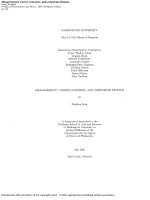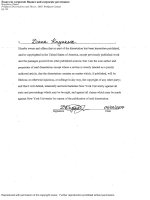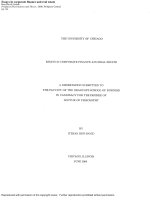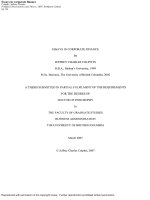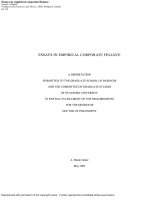CORPORATE FINANCE FINAL ASSIGNMENT
Bạn đang xem bản rút gọn của tài liệu. Xem và tải ngay bản đầy đủ của tài liệu tại đây (249.8 KB, 14 trang )
COURSE TITLE:
CORPORATE FINANCE
Students:
ID :
Lecturer:
UBIS INTAKE 5: 2013– 2014
COURSE CODE:
FIN 601
COURSE CODE:
MGT 601
JANUARY 2014
Final assignment
A. Financial Model (40 points)
1. Prepare a brief introduction of the project (maximum 200 words)
ANS joint stock company, establish soon, the company sells mobile phone installment payment
The expected parameters are as follows:
First year sales volume of 500 products, of which 20% is at sight, the rest is deferred payment. The
annual growth rate of approximately 30%, operating time of the project is 5 years.
Time installment payment sales average is 6 months.
The average sale price at sight is 3.5 million USD, the price of installment payment =120% of at sight
price. Growth rate of 7% / year, the cost = 90% of at sight price.
Inflation rate of 7% / year.4% Operating costs / revenues.installment payment costs 5% loss /
revenue, VAT 10%, 20% corporate income tax, license tax: VND 1,000,000 / year.
The cost of fixed assets and working tools VND 30,000,000, advertising and marketing costs 0.5% of
revenue. Borrowing VND 300 million, five-year loan term, fixed interest rate of 12%, the equity of
500 million VND, the discount rate is 15% / year
2. Prepare a table of assumptions for your financial model.
Product sales 1st year
Growth rate / year
Sales volumes at sight
Sales volumes installment payment
Operating time period 1
The average repayment period
The average sale price at sight
Price of installment payment
Price Growth rate
Cost
inflation rate
Operating Expenses
The rate of loss installment payment
500
30%
20%
80%
5
6
3,500,00
0
120%
7%
90%
7%
4%
5%
units
Years
Month
VND
Price at sight
Year
Price at sight
Year
Revenue
Revenue
VAT
Corporate tax
10%
20%
1,000,00
0
1%
30,000,00
0
0.50%
500,000,00
0
15%
300,000,00
0
License tax
Other expenses
The cost of fixed assets and working
tools
Advertising and marketingcosts
Equity investment
Discount rate of investors
Loans
Loan period
Fixed interest rate loans
VND
Revenue
VND
Revenue
VND
Year
VND
5 Year
12% Year
3. Prepare the financial model including: Projected Income Statement, Projected Discounted Cash
Flow and the funding schedules.
a) Projected Income Statement
Income statement
Item
Revenue
Cost
Gorss profit
Operation expenses
Interest expenses
Profit before tax
Corporate taxe
Net profit
0
1
1,946,000,000
1,575,000,000
371,000,000
138,030,001
36,000,000
196,969,999
39,394,000
157,575,999
2
2,706,886,000
2,190,825,000
516,061,000
149,878,732
28,800,000
337,382,268
67,476,454
269,905,814
3
3,765,278,426
3,047,437,575
717,840,851
208,090,316
21,600,000
488,150,535
97,630,107
390,520,428
4
5,239,766,170
4,240,914,615
998,851,555
289,187,143
14,400,000
695,264,412
139,052,882
556,211,530
5
7,290,083,765
5,900,351,003
1,389,732,762
401,954,612
7,200,000
980,578,150
196,115,630
784,462,520
-
-
Sum
20,948,014,361
16,954,528,193
3,993,486,168
1,187,140,805
108,000,000
2,698,345,363
539,669,073
2,158,676,290
Profit before tax = profit from sales - operating expenses - interest expenses
Corporate income tax = 20% x earnings before tax
Profit after tax = profit before tax - corporate income tax
Table business results in the table are based on the following parameters:
Revenue Table
Item
Sales volumes at sight
Price at sight
Revenue at sight
Sales volumes
0
1
100
3,500,0
00
350,000,0
00
400
2
130
3,745,0
00
486,850,0
00
520
3
169
4,007,
150
677,208,
350
676
4
220
4,287,6
51
943,283,1
10
879
5
286
4,587,78
6
1,312,106,80
6
1143
6
Sum
905
20,127,587
3,769,448,266
3,618
installment payment
Price installment
payment
Revenue installment
payment
Cash flow from Revenue
installment payment
4,200,0
00
1,680,000,0
00
840,000,0
00
4,494,0
00
2,336,880,0
00
2,008,440,0
00
4,808,
580
3,250,600,
080
2,793,740,
040
5,145,1
81
4,522,613,7
47
3,886,606,9
14
5,505,34
3
6,292,607,32
6
5,407,610,53
7
84,000,0
00
116,844,0
00
162,530,
004
226,130,6
87
314,630,36
6
1,596,000,0
00
500
1,946,000,0
00
1,190,000,0
00
2,220,036,0
00
650
2,706,886,0
00
2,495,290,0
00
3,088,070,
076
845
3,765,278,
426
3,470,948,
390
4,296,483,0
60
1099
5,239,766,1
70
4,829,890,0
24
5,977,976,95
9
1429
7,290,083,76
5
6,719,717,34
3
The loss installment
payment
Revenue installment
payment after the loss
Total sales volumes
Total revenue
Cash flow from sales
24,153,104
18,082,701,153
3,146,303,
663
18,082,701,153
-
904,135,058
-
17,178,566,095
4,523
20,948,014,361
2,242,168,
605
20,948,014,361
COGS table
Item
0
volumes purchased
Cost
1
2
3
500
650
3,370,5
00
2,190,825,0
00
2,190,825,0
00
845
3,606,4
35
3,047,437,5
75
3,047,437,5
75
3,150,000
Cost of goods sold
Cash flow from Cost of
goods sold
1,575,000,000
1,575,000,000
4
1,0
99
3,858,8
85
4,240,914,6
15
4,240,914,6
15
5
1,42
9
4,129,00
7
5,900,351,00
3
5,900,351,00
3
Sum
4,52
3
18,114,82
7
16,954,528,19
3
16,954,528,19
3
Operation expenses table
Item
0
1
2
3
4
5
Sum
Operation expense
77,840,000
108,275,440
150,611,137
209,590,647
291,603,351
837,920,574
Ads and marketing enpense
9,730,000
13,534,430
18,826,392
26,198,831
36,450,419
104,740,072
The cost of fixed assets and
working tools
30,000,000
License tax expense
1,000,000
1,000,000
1,000,000
1,000,000
1,000,000
Other expense
19,460,000
27,068,860
37,652,784
52,397,662
72,900,838
Total operation expenses
138,030,001
149,878,732
208,090,316
289,187,143
401,954,612
1,187,140,805
Cash flow from Total
operation expenses
138,030,001
149,878,732
208,090,316
289,187,143
401,954,612
1,187,140,805
4
5,312,879,02
6
4,665,006,07
5
7,391,689,07
7
6,490,386,10
30,000,000
5,000,000
209,480,144
b) Projected Discounted Cash Flow
Item
Cash flow from
ravenue
Cash flow from COGS
0
1
2
1,309,000,000
1,732,500,000
2,744,819,000
2,409,907,500
3
3,818,043,22
9
3,352,181,33
6
2,466,385,4
66
Sum
23,042,815,
798
18,649,981,
Cash flow from
operation expenses
150,733,001
163,766,605
Corporate rax
39,394,000
67,476,454
Cash flow from VAT
23,397,000
36,718,227
Interest expense
36,000,000
28,800,000
1,000,000
(674,024,001
)
1,000,000
License tax
Net cash flow
37,150,214
3
7
3
227,799,34
8
97,630,10
7
317,005,85
8
139,052,88
2
441,050,07
3
196,115,63
0
-
51,075,05
3
21,600,00
0
1,000,00
0
66,757,38
8
71,066,44
1
14,400,00
0
1,000,00
0
105,347,76
9
98,877,81
5
7,200,00
0
1,000,00
0
157,059,45
5
2,466,385,4
66
2,158,676,
290
5
95,231,
370
6
192,290,8
25
Sum
1,246,50
8,007
-
012
1,300,354,
885
539,669,
073
281,134,
536
-
Operating cash flow
Item
0
Beginning net cash flow
1
800,000,0
00
2
65,975,
999
3
43,12
6,213
4
49,88
3,601
The cash flow from
investors
500,000,00
0
500,000
,000
The cash flow from the
loan
The cash flow from
business
300,000,00
0
300,000
,000
2,158,67
6,290
Cash flow to pay debt
Ending net cash flow
800,000,00
0
(674,024,0
01)
37,150
,214
66,757,
388
105,347
,769
157,059,
455
60,000,0
00
60,000,
000
60,000,
000
60,000
,000
60,000,0
00
65,975,9
99
43,126
,213
49,883
,601
95,23
1,370
192,290,
825
2,466,385,46
6
300,000
,000
2,658,676,29
0
3,905,18
4,298
c) The funding schedules.
Item
Total outstanding
loans
0
300,000,000
1
300,000,000
Principal payable
60,000,000
Interest payable
36,000,000
Total Liabilities
96,000,000
2
3
240,000,00
0
60,000,00
0
28,800,00
0
88,800,00
0
4
180,000,00
0
60,000,00
0
21,600,00
0
81,600,00
0
5
120,000,0
00
60,000,0
00
14,400,0
00
74,400,0
00
Principal payable annually amount = 300,000,000 : 5 = 60,000,000
The annual interest payable = outstanding principal x rate loan early this year
Example: interest payable 1styear= 300,000,000 x 12% = 36,000,000 VND
6
60,000,
000
60,000,
000
7,200,
000
67,200,
000
Sum
900,000,000
300,000,000
108,000,000
408,000,000
B. Financial Analysis (60 points)
1. Using financial ratios and additional information revealed in the Audited Report write a short
overview on the company’s financial status
Analysis:
ASSETS
Current Assets:
Cash and Cash Equivalents
Receivables, net
Merchandise Inventories
Other Current Assets
Total Current Assets
Property and Equipment, at cost
Less Accumulated Depreciation and
Amortization
Net Property and Equipment
Notes Receivable
Goodwill
Other Assets
Total Assets
Change
2012/2011
2012
2011
$2,494
1,395
10,710
773
15,372
38,491
$1,987
1,245
10,325
963
14,520
38,975
126%
112%
104%
80%
106%
99%
14,422
14,527
99%
24,069
140
1,170
333
$41,084
24,448
135
1,120
295
$40,518
98%
104%
104%
113%
101%
Comment:
-
Total assets in 2012 did not change much compared to the previous year, increased by only 101%
specific, in which short-term assets increased 6%, fixed assets decreased by 2%, details typical
-
items as follows:
Cash and Cash Equivalents Items 2012 increased 126% over 2011 # $ 507 million.
Accounts receivable increased by 112% from 2012 to 2011 # $150 million
Fixed assets in 2012 decreased 98% compared to previous year # $379 million.
LIABILITIES AND STOCKHOLDERS’ EQUITY
Current Liabilities:
Accounts Payable
Accrued Salaries and Related Expenses
Sales Taxes Payable
Deferred Revenue
Income Taxes Payable
Current Installments of Long-Term Debt
Other Accrued Expenses
Total Current Liabilities
Long-Term Debt, excluding current installments
2012
$5,376
1,414
472
1,270
22
1,321
1,587
11,462
9,475
2011
$4,856
1,372
391
1,147
23
30
1,557
9,376
10,758
Change
2012/2011
111%
103%
121%
111%
96%
4403%
102%
122%
88%
Other Long-Term Liabilities
Deferred Income Taxes
Total Liabilities
STOCKHOLDERS’ EQUITY
Common Stock, par value $0.05; authorized: 10 billion
shares; issued: 1.754 billion shares at February 3, 2013 and
1.733 billion shares at January 29, 2012; outstanding:
1.484 billion shares at February 3, 2013 and 1.537 billion
shares at January 29, 2012
Paid-In Capital
Retained Earnings
Accumulated Other Comprehensive Income
Treasury Stock, at cost, 270 million shares at February 3,
2013 and 196 million shares at January 29, 2012
Total Stockholders’ Equity
Total Liabilities and Stockholders’ Equity
2,051
319
23,307
2,146
340
22,620
96%
94%
103%
#DIV/0!
88
87
101%
7,948
20,038
397
6,966
17,246
293
114%
116%
135%
-10,694
-6,694
160%
17,777
$41,084
17,898
$40,518
99%
101%
Comment:
-
Debt and Equity 2012 is not significantly changed compared with 2011 (101%), which increased
-
103% debt, equity decreased by 1%, the largest item changes as follows:
Accounts payable increased by 111% compared with 2011 # $ 520 million, i.e the company
-
occupiesmore than the previous year, this can be seen as a positive signal.
Business tax liabilities in 2012 increased by 121% compared with 2011, # $ 81 million
Long-term liabilities in 2012 sudden increase compared to 2011, with a 4,403% # $ 1,291 million.
This is an enormous pressure on companies.
CONSOLIDATED STATEMENTS OF EARNINGS
2012
NET SALES
Cost of Sales
GROSS PROFIT
2011
2010
74,75
4
48,9
12
25,84
2
70,39
5
46,1
33
24,26
2
67,99
7
44,6
93
23,30
4
16,5
08
1,5
68
18,07
16,0
28
1,5
73
17,60
15,8
49
1,6
16
17,46
Change
2012/2011
106%
106%
107%
Operating Expenses:
Selling, General and Administrative
Depreciation and Amortization
Total Operating Expenses
103%
100%
103%
OPERATING INCOME
6
7,76
6
1
6,66
1
5
5,83
9
(
20)
63
2
(
67)
54
5
7,22
1
2,6
86
4,53
5
1,4
99
3.0
3
1,5
11
(1
3)
6
06
(1
5)
5
30
59
3
6,06
8
2,1
85
3,88
3
1,5
62
2.4
9
1,5
70
51
56
6
5,27
3
1,9
35
3,33
8
1,6
48
2.0
3
1,6
58
3
2
2
117%
Interest and Other (Income) Expense:
Interest and Investment Income
Interest Expense
Other
Interest and Other, net
EARNINGS BEFORE PROVISION FOR
INCOME TAXES
Provision for Income Taxes
NET EARNINGS
Weighted Average Common Shares
BASIC EARNINGS PER SHARE
Diluted Weighted Average Common Shares
DILUTED EARNINGS PER SHARE
-
154%
104%
92%
119%
123%
117%
96%
122%
96%
121%
Comment:
-
Net sales increased by 106% in 2012 compared with 2011, # $4,359 million, this is a good sign of
-
the company, could this be the successful sales of deferred policy as stated in the receivables.
Gross profit increased 107% in 2012 compared with 2011, as a result, because of management
-
policies should cost well COGS decreased 1% in 2012 compared to 2011.
Net earnings in 2012 is$4,535 million, up 117% compared to 2011. I see, net sales increased by
106%, but net profits increased by 117%, difference 11%, as can be seen in this year the company
has policies to manage costs effectively, helps companies greatly reduce costs.
CASH FLOWS FROM OPERATING
ACTIVITIES:
2012
Net Earnings
Reconciliation of Net Earnings to Net Cash
Provided by Operating Activities:
$4,535
2011
2010
$3,883
$3,338
Change
2012/2011
117%
Depreciation and Amortization
Stock-Based Compensation Expense
Goodwill Impairment
Changes in Assets and Liabilities, net of the
effects of acquisitions and
disposition:
Receivables, net
Merchandise Inventories
Other Current Assets
Accounts Payable and Accrued Expenses
Deferred Revenue
Income Taxes Payable
Deferred Income Taxes
Other Long-Term Liabilities
Other
Net Cash Provided by Operating Activities
CASH FLOWS FROM INVESTING
ACTIVITIES:
Capital Expenditures, net of $98, $25 and $62 of
non-cash capital expenditures in fiscal 2012, 2011
and 2010, respectively
Proceeds from Sale of Business, net
Payments for Businesses Acquired, net
Proceeds from Sales of Property and Equipment
Net Cash Used in Investing Activities
CASH FLOWS FROM FINANCING
ACTIVITIES:
Proceeds from Long-Term Borrowings, net of
discount
Repayments of Long-Term Debt
Repurchases of Common Stock
Proceeds from Sales of Common Stock
Cash Dividends Paid to Stockholders
Other Financing Activities
Net Cash Used in Financing Activities
Change in Cash and Cash Equivalents
Effect of Exchange Rate Changes on Cash and
Cash Equivalents
Cash and Cash Equivalents at Beginning of Year
Cash and Cash Equivalents at End of Year
SUPPLEMENTAL DISCLOSURE OF CASH
PAYMENTS MADE FOR:
Interest, net of interest capitalized
Income Taxes
1,684
218
97
1,682
215
0
1,718
214
0
100%
101%
-143
-350
93
698
121
87
107
-180
8
6,975
-170
256
159
422
-29
14
170
-2
51
6,651
-102
-355
12
-133
10
-85
104
-61
-75
4,585
84%
-137%
58%
165%
-417%
621%
63%
9000%
16%
105%
-1,312
-1,221
-1,096
107%
0
-170
50
-1,432
101
-65
56
-1,129
0
0
84
-1,012
0%
262%
89%
127%
0
1,994
998
0%
-32
-3,984
784
-1,743
-59
-5,034
509
-1,028
-3,470
306
-1,632
-218
-4,048
1,474
-1,029
-2,608
104
-1,569
-347
-4,451
-878
3%
115%
256%
107%
27%
124%
35%
-2
-32
2
6%
1,987
$2,494
545
$1,987
1,421
$545
365%
126%
$617
$2,482
$580
$1,865
$579
$2,067
106%
133%
Comment:
-
Net Cash Provided by Operating Activities increased by 105% in 2012 compared with 2011, #
-
$324 million
Net Cash Used in Investing Activities increased by 127% in 2012 compared to 2011, ie increased
-
investment company added $303 million.
Net Cash Used in Financing Activities 2012 - $5,034 million, up 124% compared to 2011
The amount of cash at the beginning of 2012 is quite large, to use effectively, in the company has
increased investment and financial activities for effective use of this. Sources money ending
stocks fell to U.S. $ 509 million.
To better understand the operations of the company, we analyze the indicators, detailed as follows:
a) Group index payments
2012
2011 Change 2012/2011
Current ratio
1.34
1.55
87%
Quick Ratio
0.41
0.45
91%
Cash Ratio
0.22
0.21
103%
Working capital
3,910
5,144
76%
Net cash flow from operating activities
Cash flow from operations to current
liabilities
6,975
6,651
105%
0.61
0.71
86%
Comment:
The quick ratio and current ratio in 2012 fell sharply compared to the previous year, respectively at
91% and 87%. This is because the company has long-term debt to pay quite large in 2012. However,
based on industry data, the average of the index remained safe, the company has enough liquidity and
debt maturity, notably the ability to pay in cash by 2012 higher than in 2011.
Working capital in 2012 although fell sharply compared to 2011, 76% of # $1,234 million, but still at
high levels ($3,910 million), which suggests that the company is capable of greater financial
autonomy, not imbalance
Net cash flow from operating activities from 2012 increased 105% compared with 2011, # $324
million, this shows the cash flow from operating activities likely pay the majority of costs for
companies, 2012 was 61%.
b) Group of performance indicators
2012
Receivables turnover rate
2011 Change 2012/2011
56.63
112.98
50%
Debtor days
6.45
3.23
200%
Inventory turnover rate
4.65
8.94
52%
Days to sell average inventory
78.49
40.85
192%
Operating cycles
84.93
44.08
193%
7.17
15.01
48%
50.87
24.31
209%
1.82
1.74
105%
3,800
3,890
98%
Current liabilities turnover rate
Day to current liabilities average
Total Asset Turnover
Free cashflow
Comment:
-
Receivables Turnover in 2012 fell sharply compared to 2011, the right half, respectivelydown to
50%. This could be a business strategy to increase the company's revenue and market share.
Compared to competitors in the industry, the average number of days to collect a debt of about
-
100 days, a desirable figure in Vietnam.
Inventory Turnover also fell by nearly half in 2012, corresponding to 52% compared to 2011,
which suggests that consumer demand from the U.S. and several countries around the world is
still very slow, the cause may be due to economic the world has yet to recover significantly.
However, the average number of days inventory is about 2.5 months # 78.49 days. This is not the
-
disappointing numbers, and those in Vietnam (approximately 100-180 days), it remains a dream.
Payables Turnover in 2012 fell sharply compared to 2011, 48%. As such, the company, thanks to
the advantage of his size has raised occupancy time from suppliers to offset receivables and
-
inventory. Time payables 50.87 per day, an increase of 209% compared to 2011.
Total Asset Turnover increased by 105% in 2012 compared to 2011, ie the profitability of 1
copper assets in 2012 is higher than 2011.
c) Group index of leverage and asset structure and capital
Ratios
2012
2011
Change 2012/2011
Measure of long-term credit risk
Debt ratio
0.57
0.56
102%
Debt -Equity ratio
1.31
1.26
104%
Equity Multiplier
2.31
2.26
102%
Trend in net cash flow from operating activities
324
2,066
16%
Interest coverage ratio
12.29
10.99
112%
Cash coverage ratio
14.77
13.59
109%
Comment:
-
Debt ratio increased in 2013 compared to 2011, the 121%. However, with the debt ratio 0.57% vs.
industry average and in comparison with Vietnam is moderate. The company has financial
-
autonomy relatively.
Rate debt / equity at 1:31 in 2012, an increase of 104% compared to 2011. The ability to fend for
-
corporate debt is not high.
Trend in net cash flow from operating activities from 2012 although still increased compared to
2011 but has decreased compared with the trend of 2011-2010. This shows that the situation tends
-
to collect money not well developed.
The index Interest coverage ratio and cash coverage ratio increased compared with 2011, and
respectivelyat 12:29; 14.77. The company has the ability to pay great interest.
d) Group profitability index
Gross Profit rate
Operating Expense ratio
Operating income
0.35
0.24
7,766
0.34
0.25
6,661
Change
2012/2011
100.30%
96.71%
117%
Net income on sales
0.0607
0.0552
110%
Earning per share (EPS)
3.03
Return on asset (ROA)
0.11
2.49
0.10
122%
116%
Return on equity (ROE)
0.25
0.22
117%
Ratios
Comment:
2012
2011
-
In 2012, the rate Gross Profit and Operating Expense ratio is done better than the 2011, Namely
Gross Profit rate increase 1%
and Operating Expense ratio
down 1% => profit making
company's EBITDA will increase more than 2% of revenue, which is demonstrated is the ratio of
-
net income on sales in 2012 increased by 110% compared to 2011.
ROA and ROE in 2012 were 11% and 25%, respectively increased 116% and 117% compared to
2011. In the time of the current economic crisis that ROE of 25% is a desirable thing most
businesses in the world (Warren Buffett Legendary yielding 20-30% / year)
Summation:
The financial situation of the company in 2012 pretty good company, namely: increased revenue,
increased profitability, asset growth, cost reduction, inventory and accounts receivable have increased
but were offset by liabilities returns and remains within safe ranges, plus cash flow from operations
also increased, increasing the ability to pay interest, ROA, ROE increased and higher. This
demonstrates why the share price is the average closing 64.235USD 2012, an increase of 159%
compared to 2011.
2. Make decision whether you would or would not invest into the company. Explain your decision.
If i’m a investor, I will invest in to the company. Because of 3 reason below:
-
Years 2010, 2011 and 2012 is a serious crisis of the world economy, especially in the U.S. but the
financial indicators: total assets, revenue, profit growth is good, especially ROE 2012 is 25%.
Since quarter 2/2013, the U.S. economy is recovering and as a result, business activities of the
-
company will be better.
The company has a global market (about 2,256 stores), available in major markets such as the
-
U.S., Canada, Mexico, China ... so that can share risk country and risk areas.
The high liquidity of stock: preferred by the market and appreciated company stock.
However, when investing in this company, I will invest in short-term and will use technology to cut
losses when the stock price dropped 20% over the closing price of 2012. reason:
Ratios
Market-to-book ratio
Price per earnings ratio (P/E ratio)
Dividend yield
2012
2011 Change 2012/2011
5.42
3.53
153%
16.28
130%
2
1.23
0.61%
According to the table above, we see,
-
Index market-to-book ratio has increased by 153% from 2012 to 2011, and the difference value
was 5.42 times, ie the value of the company has been pushing the market up 5.42 times the book
-
value.
The Price per earnings ratio (P / E ratio) increased by 130% in 2012 compared with 2011, and is
-
at times very high 21.23.
Also, if only to get dividend, investors must take 164.7 years to recoup the principal spent closing
prices in 2012 (not including the value of cash flow over time).
Thanks for see.

